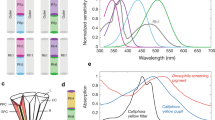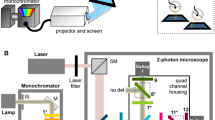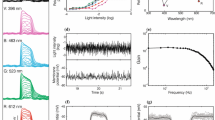Summary
The transfer properties of the optical system in the arthropod compound eye are determined by the interommatidial angle Δ ϕ, influencing the resolving power, and by the width of the visual fields of single ommatidia Δ ϱ, influencing the response at high spatial frequencies of brightness distributions in the object space. The energy transfer/ receptor is proportional to (Δϕ Δ ϱ)2 and decreases with in-inreasing approximation of the perfect-imaging condition: gDϕ → 0; Δϱ → 0. However, a value Δϕ Δϱ > 0 has to be maintained in order to overcome the threshold of nervous excitation at a certain minimum-brightness level. Theoretical treatment yields Δϱ/Δϕ=0.62 to 0.88 as the corresponding optimum-imaging relation. The actual ratio can be derived from measurements of the optomotor reactions to the movement of periodic brightness patterns. The approximate value 0.76 is obtained from the fruitfly Drosophila with normal and mutant eye pigmentation. As a result, the parameters of this imaging system are found to be established in a way that enables optimum performance at sufficient illumination. An dieser Stelle möchte ich Dr. W. Reichardt für sein eingehendes Interesse und manche anregende Diskussion über die Sehvorgänge im Komplexauge meinen Dank sagen. Dr. K. Kirschfeld verdanke ich ebenfalls wertvolle Hinweise. Herrn E. Freiberg bin ich für die Anfertigung der Abbildungen sehr verbunden.
Similar content being viewed by others
Literatur
Autrum, H.: Die spektrale Empfindlichkeit einzelner Sehzellen des Bienenauges. Z. vergl. Physiol. 48, 357 (1964).
Autrum, H., u. H. Stumpf: Das Bienenauge als Analysator für polarisiertes Licht. Z. Naturforsch. 5b, 116 (1950).
Autrum, H., u. I. Wiedemann: Versuche über den Strahlengang im Insektenauge. Z. Naturforsch. 17b, 480 (1962).
Barlow, H. B.: The size of ommatidia in apposition eyes. J. exp. Biol. 29, 667 (1952).
Burkhardt, D.: Spectralsensitivity and other response characteristics of single visual cells in the arthropod eye. Symp. Soc. exp. Biol. 16, 86 (1962).
Burkhardt, D., u. L. Wendler: Ein direkter Beweis für die Fähigkeit einzelner Sehzellen des Insektenauges, die Schwingungsrichtung polarisierten Lichts zu analysieren. Z. vergl. Physiol. 43, 687 (1960).
Burtt, E. T., and W. T. Catton: Visual perception of movement in the locust. J. Physiol. (Lond.) 125, 566 (1954); - A diffraction theory of insect vision. I. An experimental investigation of visual acuity and image formation in the compound eyes of three species of insects. Proc. roy. Soc. B 157, 53 (1962).
McCann, G. D. and G. F. MacGinitie: Optomotor response studies of insect vision. Proc. roy. Soc. B (im Druck).
Enoch, J. M.: Opticalproperties of the retinal receptors. J. opt. Soc. Amer. 53, 71 (1963).
Exner, S.: Die Physiologie der facettierten Augenvon Krebsen und Insekten. Leipzig: Franz Deutike (1891).
Fermi, G., u. W. Reichardt: Optomotorische Reaktionen derFliege Musca domestica. Kybernetik 2, 15 (1963).
Gavel, L.V.: Die „kritische Streifenbreite” als Maß der Sehschärfe bei Drosophila melanogaster. Z. vergl. Physiol. 27, 80 (1939).
Götz, K. G.: Optomotorische Untersuchung des visuellen Systems einiger Augenmutanten der Fruchtfliege Drosophila. Kybernetik 2, 77 (1964).
Hartline, H. K., and F. Ratliff: Inhibitory interaction of receptor units in the eye of Limulus. J. gen. Physiol. 40, 357 (1957).
Hassenstein, B.: Opto-kinetische Wirksamkeit bewegter periodischer Muster. (Nach Messungen am Rüsselkäfer Chlorophanus viridis.) Z. Naturforsch. 14b, 659 (1959).
Hecht, S., and G. Wald: Thevisual acuity and intensity discrimination of Drosophila. J. gen. Physiol. 17, 517 (1934).
Kirschfeld, K.: Das ana-tomische und das physiologische Sehfeld der Ommatidien im Komplexauge von Musca. Kybernetik (im Druck).
Kirsch-Feld, K., U. W. Reichardt: Die Verarbeitung stationärer optischer Nachrichten im Komplexauge von Limulus (Ommatidien-Sehfeld und räumliche Verteilung der Inhibition). Kybernetik 2, 43 (1964).
Kuiper, J. W.: The optics of the compound eye. Symp. Soc. exp. Biol. 16, 58 (1962).
Kunze, P.: Untersuchung des Bewegungssehens fixiert fliegender Bienen. Z. vergl. Physiol. 44, 656 (1961).
Müller, J.: Zur vergleichenden Physiologie des Gesichtssinnes. Leipzig 1826.
Ratliff, F., H. K. Hartline, and W. H. Miller: Spatial and temporal aspects of retinal inhibitory interaction. J. opt. Soc. Amer. 53, 110 (1963).
Reichardt, W.: Autocorrelation, a principle for the evaluation of sensory information by the central nervous system. Aus: Sensory communication, edit, by W. A. Rosenblith, S. 303 uff. Mass: M.I.T. Press 1961; - Uber das optische Auflösungsvermögender Facettenaugen von Limulus. Kybernetik l, 57 (1961).
Reichardt, W., u. G. MacGinitie: Zur Theorie der lateralen Inhibition. Kybernetik l, 155 (1962).
Reichardt, W., u. D. Varjú: übertragungseigenschaften im Auswertesystem für das Bewegungssehen (Folgerungen aus Experimenten an dem Rüsselkäfer Chlorophanus viridis). Z. Naturforsch. 14b, 674 (1959).
Rogers, G. L.: A diffraction theory of insect vision.II. Theory and experiments with a simple model eye. Proc. roy. Soc. B 157, 83 (1962).
Thorson, J.: Dynamics of motion perception in the desert locust. Science 145, 69 (1964).
Varjú, D.: Optomotorische Reaktionen auf die Bewegungperiodischer Helligkeitsmuster. (Anwendung der Systemtheorie auf Experimente am Rüsselkäfer Chlorophanus viridis). Z. Naturforsch. 14b, 724 (1959).
Vowles, D. M.: Unver-öffentlicht. Nach McCann u. MacGinitie, loc. cit. - Vries, H. de: Physical aspects of sense organs. Progr. Biophys. 6, 208 (1956).
Vries, H. de, and J. W. Kuiper: Optics of the insect eye. Ann. N.Y. Acad. Sci. 74, 196 (1958).
Washizu, Y., D. Burkhardt, and P. Streck: Visual field of single retinula cells and interommatidial inclination in the compound eye of the blowfly Calliphora erythrocephala. Z. vergl. Physiol. 48, 413 (1964).
Waterman, T. H.: Direc-tional sensitivity of single ommatidia in the compound eye of Limulus. Proc. nat. Acad. Sci. (Wash.) 40, 252 (1954).
Author information
Authors and Affiliations
Rights and permissions
About this article
Cite this article
Götz, K.G. Die optischen Übertragungseigenschaften der Komplexaugen von Drosophila. Kybernetik 2, 215–221 (1965). https://doi.org/10.1007/BF00306417
Received:
Issue Date:
DOI: https://doi.org/10.1007/BF00306417




